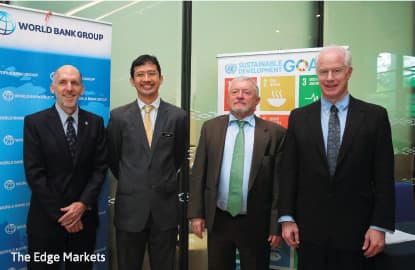
KUALA LUMPUR: The national poverty line index (PLI) used by the government to measure poverty is flawed as it is based on a fixed level of income, says a researcher, pointing out that this excludes people earning higher levels of income but still living in poverty.
“The poverty line is just a starting point,” said Prof Sulochana Nair, a board member of Yayasan Sejahtera, a foundation which seeks to alleviate poverty in the country.
“Currently, the government classifies urban poverty as [those with an income of] RM800 or RM900,” she told The Edge Financial Daily.
“But who earns such [a low level of] income?”
She said there are many poor people in urban areas who earn higher incomes but live in hardship.
“Due to the complexity of the issues, the government has introduced the bottom 40% (B40) income group. It’s because it was difficult to make policies based on the PLI, which was 0.6% [in 2014] and near zero now. It is too low,” she added.
The PLI is based on the household income and expenditure survey, conducted twice every five years, and the consumer price index. This is in line with international standards.
Sulochana, who has undertaken several research projects focusing on poverty groups, said the government came out with multidimensional indicators in the 11th Malaysia Plan, such as access to health and education, and living standards, as a relative measure, although the PLI is seen as a starting point.
But the government has failed to add employment as an indicator, which the professor sees as critical in measuring income levels.
At a panel discussion last week, Sulochana said the reality of people living in poverty was not reflected in official data, as many were not aware that they are poor as they live in remote areas or have not been told by government officials of their status.
“They don’t realise they are poor because they have not been told. They have no access to entitlements, which are allocated in the federal budget. There is a severe lack of communication on this to them,” she said.
The discussion, jointly organised by the World Bank Group Global Knowledge and Research Hub in Malaysia and the United Nations Development Programme, was held in conjunction with the International Day for the Eradication of Poverty and the End Poverty Campaign.
According to reports, in June 2015, Malaysia’s poverty level fell to 0.6% from 1.7% in 2012, having dropped from 49.3% in 1970, due to various poverty eradication programmes introduced.
In 2014, the poverty threshold was RM930 in Peninsular Malaysia, RM990 in Sarawak and RM1,170 in Sabah and Labuan, while household incomes of below RM580 in Peninsular Malaysia, RM660 in Sarawak and RM710 in Sabah and Labuan were categorised as hardcore poor.
Another speaker, Economic Planning Unit distribution section director Muhammad Idris, said there was a limitation to the delivery system of aid to the people, which allegedly led to “leakages”.
“We should be talking about a database, identifying the target group and designing the right programme to reach the target group [and] to avoid leakages. The other thing is the market environment and the uncertainty of the socio-economic environment [which must be considered] to make sure what we plan reaches the target groups,” he said.
Muhammad, who was responding to a question on how to minimise leakages in the aid delivery system, said there should be a supportive market environment and conducive sociopolitical environment to support the efforts, and ensure sustainability.
“But from the common perspective, most of us feel that if we can have a good and quality database, and an efficient system, then we can plug the leakages. That is important but to me, I think it is insufficient.”
He also urged groups working with poor communities to become strategic partners of the government to bring people out of poverty and vulnerability.